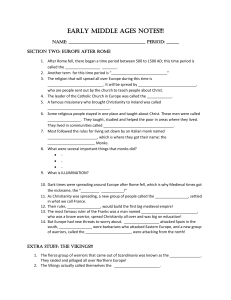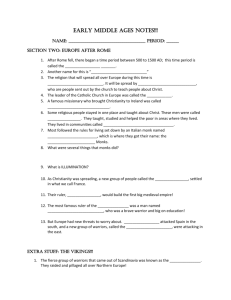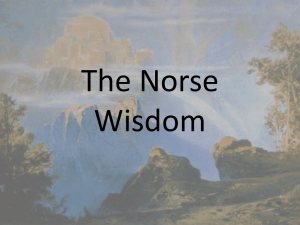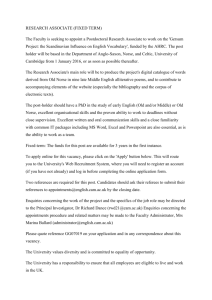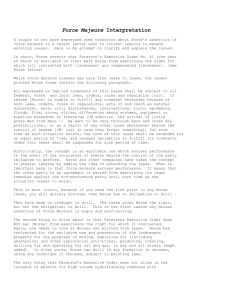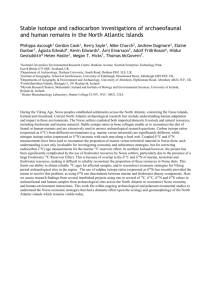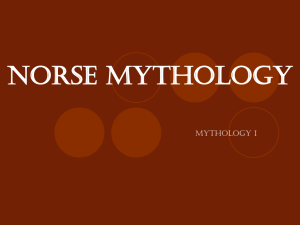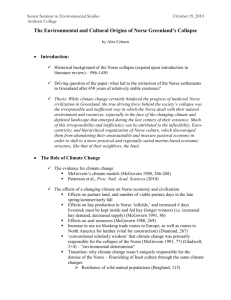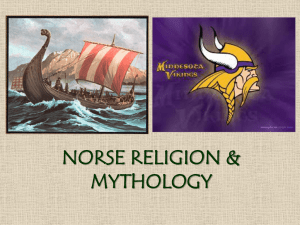Early Medieval Europe Notes
advertisement
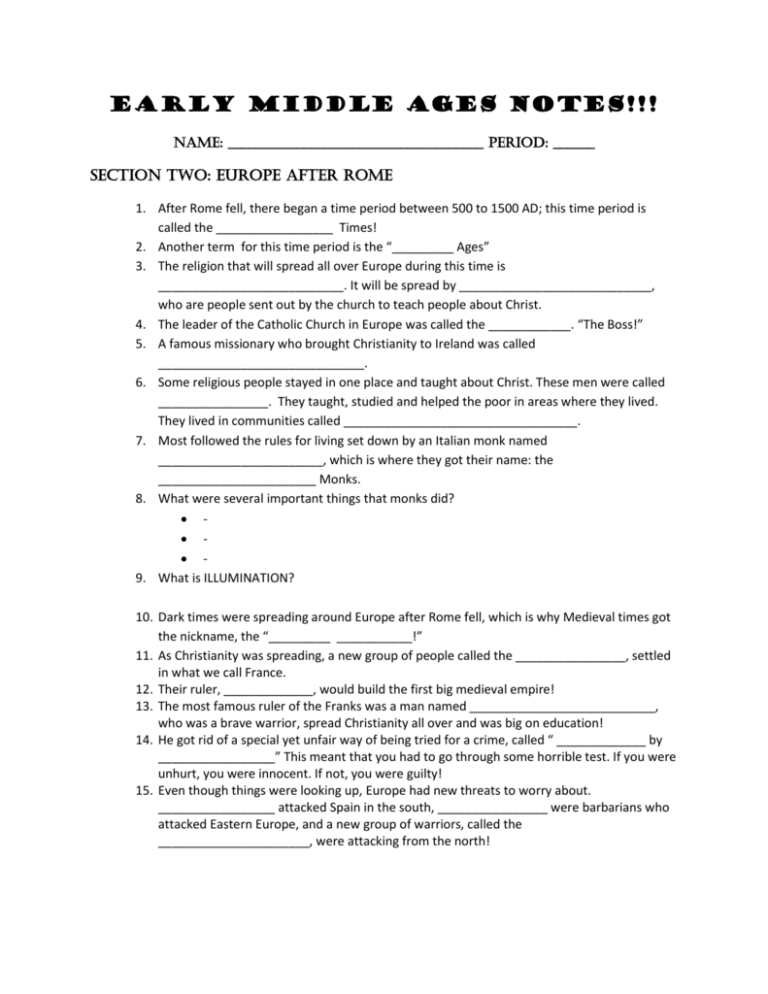
Early Middle Ages Notes!!! Name: _____________________________________ Period: ______ Section Two: Europe after Rome 1. After Rome fell, there began a time period between 500 to 1500 AD; this time period is called the _________________ Times! 2. Another term for this time period is the “_________ Ages” 3. The religion that will spread all over Europe during this time is ___________________________. It will be spread by ____________________________, who are people sent out by the church to teach people about Christ. 4. The leader of the Catholic Church in Europe was called the ____________. “The Boss!” 5. A famous missionary who brought Christianity to Ireland was called ______________________________. 6. Some religious people stayed in one place and taught about Christ. These men were called ________________. They taught, studied and helped the poor in areas where they lived. They lived in communities called __________________________________. 7. Most followed the rules for living set down by an Italian monk named ________________________, which is where they got their name: the _______________________ Monks. 8. What were several important things that monks did? 9. What is ILLUMINATION? 10. Dark times were spreading around Europe after Rome fell, which is why Medieval times got the nickname, the “_________ ___________!” 11. As Christianity was spreading, a new group of people called the ________________, settled in what we call France. 12. Their ruler, _____________, would build the first big medieval empire! 13. The most famous ruler of the Franks was a man named ___________________________, who was a brave warrior, spread Christianity all over and was big on education! 14. He got rid of a special yet unfair way of being tried for a crime, called “ _____________ by _________________” This meant that you had to go through some horrible test. If you were unhurt, you were innocent. If not, you were guilty! 15. Even though things were looking up, Europe had new threats to worry about. _________________ attacked Spain in the south, ________________ were barbarians who attacked Eastern Europe, and a new group of warriors, called the ______________________, were attacking from the north! Extra Stuff: The Vikings!!! 1. The fierce group of warriors that came out of Scandinavia are known by many today as the _______________. They raided and pillaged all over Northern Europe! 2. The Vikings came from ________________________________, in the cold, northern part of Europe. 3. The Vikings actually called themselves the ______________________. 4. In their language, “to go out and fight and pillage” means to “_____ ____ __________________” 5. A Norse warrior who fights without mercy and almost in a bloodthirsty trance is called a _________________________. 6. Norse raiders mostly went after ____________________________, where defenseless monks lived. 7. The leader of a Norse community is called an _____________. 8. The Norse version of democracy was called the ___________. All free men were able to participate! 9. The Norse alphabet, inscribed on stones, are called _______________. 10. ___________________ are long stories or poems that make up Norse history. Within them are _____________ that tell the adventures of heroes, gods and adventurers. Myths! 11. One of the most famous is a story about a fierce Norse warrior called _____________________, who fights the monster ___________________, and is awarded great riches by King _______________________. 12. The Norse explored, traded and raided using a type of ship called a ___________________________. The Norse called them ___________________. 13. These ships had _________________________, or heads that were attached to the front of the boat. They were usually dragons, to fend off sea monsters and to look terrifying! 14. One famous Norse warrior/explorer, with a very bad temper, was named _________ ____ ________. 15. He founded the colony of _____________________________. He told people that it had much “green land” to encourage people to move there. 16. His son, _____________________ ___________________, also explored, and was said to have discovered the land of __________________, which is in modern day __________________________, ______________________. 17. In __________________________, the Norse fought the Natives Americans there, who they called _________________________. It didn’t go so well for the Norse. 18. The Universal Tree in Norse mythology is called ________________________________. The gods lived in _____________________, and humans lived in _______________________. The __________________ were sisters who determined each person’s future and fate. 19. When a warrior died, he would go to ________________________, to drink mead with the __________________________, the female warriors who ran the place (and who brought slain warriors there as reward!)! 20. In the end, the Norse would convert to ______________________________. Section 3: Feudalism and Manor Life 1. In medieval society, the “top dog” of a country was its _______________. For their loyalty, kings would give land to the wealthy nobles, who were also called ________________. 2. The land owned by a lord is called a ____________. 3. Peasants who worked the lord’s land in exchange for protection were called ____________. Their lives were pretty miserable. 4. Serfs’ houses were constructed out of ______________ and ___________, which is a mixture of criss-crossed sticks and mud. 5. Lords would then hire professional soldiers to protect their land. These soldiers were called _______________________. 6. To become a knight, you must start off young and serve a knight as his _______________. 7. When you finally become a knight, you go through a ceremony called _____________________. 8. Sometimes nobles would give a knight their own land, called a __________. 9. A knight who promised to serve a lord is called that lord’s ________________________. 10. Draw out the social pyramid of FEUDALISM!!! 11. This system of promises between a lord and knight is called ___________________________. 12. 13. What were the lord’s duties? What were the vassal’s duties? - 14. Feudalism came to England when a French noble called _______________________ the ___________________ invaded it in 1066. He rewarded his knights with land there! 15. 16. 17. Describe manor life for a peasant: Describe manor life for a lord: Some noble women had some power, too! A powerful noblewoman in France who had political power was named __________________ of __________________________. Section 4: Feudal Society 1. A powerful noblewoman who became the queen of France was named __________________ of Aquitaine. 2. Why did many people move to the cities during medieval times? 3. What did knights start wanting instead of land? 4. Japan and Medieval Europe were a lot alike! In Japan, warriors called ______________________ followed the code of ____________________. In Europe, soldiers called ____________________ lived by a code called ________________________. They were very much the same! 5. Describe how knights were supposed to act under chivalry: 6. Fill in the differences chart between Japan and Europe. Japan Europe Code of living Religion Art had to with… Extra Stuff: Castles! 1. The very first type of castle was called a ________________ and ________________. 2. A large wooden fence that surrounded a town or early castle was called a ___________________________. 3. The ____________ _____________ is where the lord or king entertained his guests and held feasts! 4. Musicians as entertainers were called ______________________. 5. The area of the castle meant for worship was called a _________________. 6. The wall around a castle was called a _________________ wall. 7. To surround a castle to try and take it over is called a _____________. 8. A catapult-type weapon used to smash down walls is called a __________________________. 9. A special hole where defenders could drop hot oil, garbage, stones or dead animals down on attackers was called a ________________ ___________.
